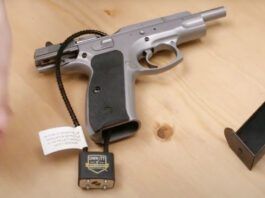Weaver Expands Tactical Line of Rings and Bases
ONALASKA, Wis. – Weaver announces a new offering to the tactical world. The new Weaver Tactical Rings (MSRP: $34.49) & Bases (MSRP: $18.49) deliver unparalleled performance to those that demand nothing less when it comes to securing their optics and maintaining zero. Available spring of 2008.
Champion Introduces the EasyHit Fiber Optic Sight
ONALASKA, Wis. – Champion introduces the EasyHit Fiber Optic Sight (MSRP: $21.49). Available spring 2008. In cooperation with world-renown exhibition shooter Tom Knapp, Champion brings this patented training system to shooters looking to increase their score, bag limit or outdoor fun.
Browning Introduces Fitted Luggage Cases And Flex Case Models To Its Gun Case Line...
MORGAN, UTAH — Browning has added new models of fitted and flexible gun cases to offer exceptional quality, protection and versatility to meet various transportation requirements.
Browning Offers Wide Body Models And Storage Systems In Pro-Steel Security Safe For 2008
MORGAN, UTAH — Browning added larger size safe models in the Medallion Series and TheftGard Series giving consumers more storage capacity for their firearms and other valuables.
Browning introduces new Night Seeker Pro Cap Light, expands Black Ice Flashlight line-up
MORGAN, UTAH — Browning expands its’ line of flashlights with the addition of the new Night Seeker Pro Cap Light, Black Ice Long-Run Summit Headlamps, Pro Hunter lights.
Champion Unveils New DuraSeal Self-Sealing Target
ONALASKA, Wis. – Champion Traps & Targets® announces DuraSeal™ Spinner Targets. Available in spring 2008 and offered in a prairie dog configuration (single and multi-dog options), the new DuraSeal™ Spinner Targets (MSRP: $16.95-$34.95) features either 5½” or 7” targets that are counter-weighted for maximum wobble and spin.
Champion Offers New Pellet Trap to Airgun Enthusiasts
ONALASKA, Wis. –Champion Traps and Targets, introduces their new Airgun Pellet Trap (MSRP: $32.49)—available spring 2008.
Champion Offers New Line of Shell Pouches for Shotgunners
ONALASKA, Wis. – Champion now offers comfortable, stylish shell pouches for shotgunners (MSRP: $21.49-$26.49). Available in spring 2008.
Shooters Ridge Expands 10/22 Line to Include Custom Stocks & Target Barrels
ONALASKA, Wis. – Shooters Ridge introduces a new line of 10/22 custom stocks and LR target barrels available in spring 2008.
Shooters Ridge Goes Ape with the Gorilla Range Bag
ONALASKA, Wis. – Shooters Ridge introduces the new Gorilla Range Bag. The Gorilla Range Bag (MSRP: $74.49) is a sectional, filled rest that can be used in eight different configurations. Available in the spring 2008.
Gunslick Introduces New AR-15 Pull-Through Kit
Gunslick demonstrates their support of law enforcement, armed forces and ”black gun” shooters with a product designed specifically for AR-15’s. Introducing the Gunslick AR-15 Pull-Through Kit (MSRP: $23.49)—available spring of 2008.
Shooters Ridge Goes Deluxe with New Bi-pod
ONALASKA, Wis. – Shooters Ridge introduces a new bi-pod certain to get shooters on game faster and steadier than ever before. Introducing the new Shooters Ridge Deluxe Bi-pod (MSRP: $145.49)—available in spring 2008.






























